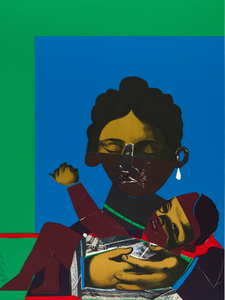
ROMARE BEARDEN
School, 1972
Color photo lithograph
Hand signed in black marker on the front; also bears plate signature on top
Co-published by Automation House and E.A.T., produced by Local One, Amalgamated Lithographers of America, New York
Unframed
Wonderful 1972 Romare Bearden print
Rarely seen on the market
Co-published by Automation House and E.A.T., produced by Local One, Amalgamated Lithographers of America, New York
About Romare Bearden:
Two fundamental assumptions underlie my attitude to my work. First, I feel that when some photographic detail, such as a hand or an eye, is taken out of its original context and is fractured and integrated into a different space and form configuration, it acquires a plastic quality it did not have in the original. . . . Secondly, I think a quality of artificiality must be retained in a work of art, since . . . the reality of art is not to be confused with that of the outer world. Art . . . is artifice, or a creative undertaking, the primary function of which is to add to our existing conception of reality.” - Romare Bearden, “Rectangular Structures in My Montage Paintings,” Leonardo vol. 2, 1969, 17-18
One of the great innovators of twentieth-century collage, Romare Bearden (1911–1988), was born in Charlotte, North Carolina, and raised by parents who nurtured his intellect and exposed him to art. In 1914, the family moved to Harlem, where their circle of friends included luminaries of the Harlem Renaissance. As a teenager, Bearden spent considerable time with his grandparents in Pittsburgh, Pennsylvania and, at sixteen, he spent a summer working for US Steel, which later inspired him to expose the conditions facing black steelworkers in an article for Opportunity: Journal of Negro Life. After high school, Bearden enrolled at Lincoln University in Pennsylvania before eventually transferring to New York University, earning a BS in Education in 1935. In the fall of that year, he took a job as a caseworker for the New York City Department of Social Services, a position he held until 1969.
After college, Bearden took night classes at the Art Students League, where he studied with George Grosz. He began his professional career as a political cartoonist and was involved with the Harlem Artists’ Guild, frequenting the sessions and exhibitions held at Charles Alston’s studio at 306 West 141st Street. Alston was Bearden’s cousin by marriage, and the studio was the venue for Bearden’s first solo show in 1940. During World War II, Bearden enlisted in the US Army, serving in a segregated unit stationed in New York. He continued to work and exhibit during the war and, in 1945, Bearden joined Kootz Gallery’s stable of artists, which included Carl Holty, William Baziotes, Adolf Gottlieb, Alexander Calder, and Robert Motherwell. These eminent figures of mid-century modernism met regularly to discuss art, abstraction, and composition; their monthly debates proved to be a stimulating environment for Bearden, who wrote extensively about art.
After studying in Paris with GI Bill funding, Bearden resumed his job at Social Services in 1952, but by 1954 he decided to direct more time and energy toward making art. To hone his composition skills, Bearden made duplicates of European masterworks on a Photostat machine and began experimenting with color, divorcing it from figural representation and applying it in “marks and patches.” Through these experiments, Bearden “realized . . . tracks of color tended to fragment my compositions. That was when I went back to the Dutch masters, to Vermeer and De Hooch, in particular, and it was then I came to some understanding of the way these painters controlled their big shapes, even when elements of different size and scale were included within those large shapes.” This rectangular organization, as Bearden called it, became his foundational approach to composition.
In 1963–1964 Bearden took on collage as his primary medium, which he favored for its embodiment of his ardent belief that “art is made from other art.” Bearden often added gouache, ink, pencil, oil, and spray paint to his kaleidoscopic surface of cut-up collage elements, heightening the effect of his formal structures and deepening the chromatic range of his images. The subjects of Bearden’s collage works are as expansive as his own talent and interests, ranging from Greek mythology, jazz, blues, European Old Masters, and Black American life in both urban and rural settings. He once explained, “I seek connections . . . People in a baptism in a Virginia stream are linked to John the Baptist, to ancient purification rites, and to their African heritage.” For Bearden, collage became a metaphor for this idea of interconnectivity as well as a means to reveal it. Featuring conjure women and other African traditions that survived the ruptures of slavery and diaspora, Bearden’s work redefined the image of humanity in terms of black experiences, be they African, American, or Caribbean.
- Courtesy to Michael Rosenfeld Gallery










